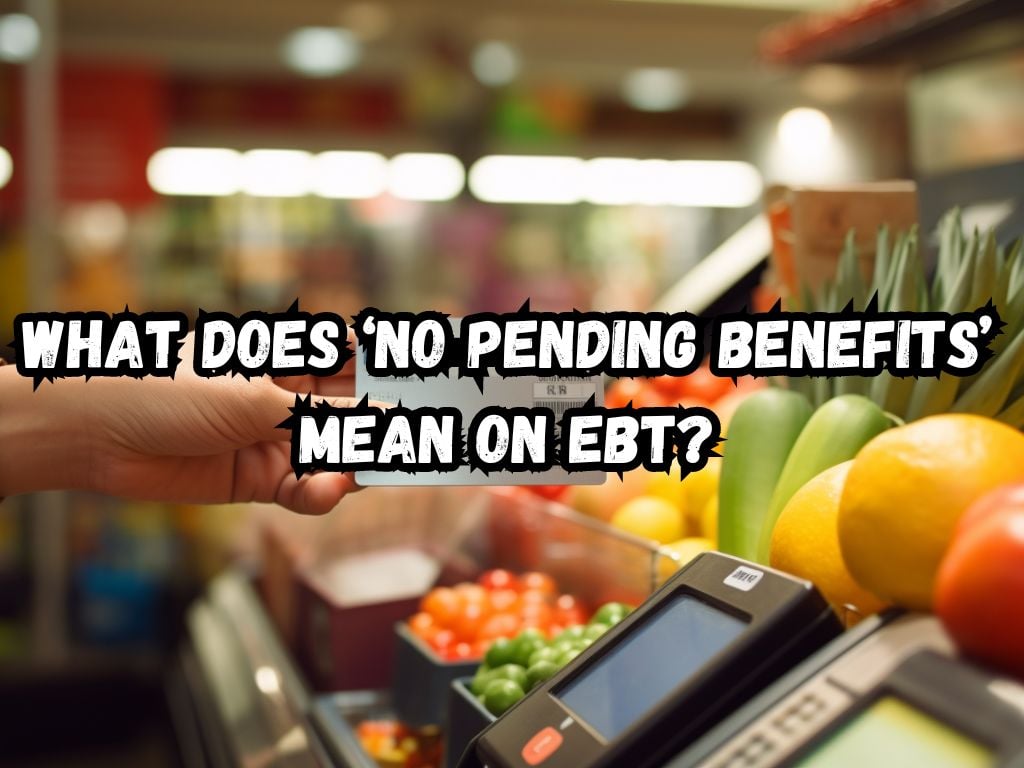Electronic Benefit Transfer (EBT) is a system that allows state welfare departments to issue benefits using a payment card. For many individuals and families, it is a lifeline, providing access to essential food and cash benefits.
Encountering the message ‘No Pending Benefits’ on an EBT card can be a source of confusion and concern. This article delves into what this message means, explores its potential causes, and provides guidance for action.
What Does No Pending Benefits Mean on EBT?
When an EBT card reads ‘No Pending Benefits,’ it typically means that there are no future benefit payments scheduled to be deposited onto the card.
This can be alarming, especially if you rely on these benefits. Let’s decipher what this message signifies and investigate why it might appear, so you can take the right steps forward.

Potential Reasons for No Pending Benefits
A number of scenarios might lead to the emergence of a ‘No Pending Benefits’ message. It is important to understand each possibility to properly address the issue.
Account Suspension or Closure Considerations
One of the most serious reasons for seeing no pending benefits is an account suspension or closure. This might happen if there has been a violation of program rules or if there is a need for additional verification.
Administrative Errors or Delays
Sometimes errors occur. These can include mistakes in data entry or delays in the processing of benefits. While frustrating, such errors are often easily corrected.
The End of the Benefit Period Without Renewal
Benefits are often granted for a specific period. If this period ends without a renewal application being processed, you might see ‘No Pending Benefits’ on your card.
How to Address No Pending Benefits?
If your EBT card is showing ‘No Pending Benefits,’ don’t lose hope. There are clear steps you can take to resolve the issue.
- Contacting EBT Customer Service: The first step is to reach out to the EBT customer service hotline. The number is usually found on the back of your EBT card.
- Checking Account Status Online: Many states provide online portals where you can check the status of your EBT account and any pending benefits.
- Review Eligibility for Renewal: Regularly reviewing your eligibility and understanding the timeline for renewal can prevent unforeseen benefit disruptions.
Preventing Future ‘No Pending Benefits’ Scenarios
To avoid recurring issues with ‘No Pending Benefits,’ staying vigilant is key.
- Tips for Keeping Track of Benefit Periods: Mark your calendar with important dates related to your benefit period. This proactive approach will help ensure that benefits continue uninterrupted.
- Understanding Renewal Requirements: Knowing and preparing for renewal requirements well before the due date can prevent lapses in benefits.
- Regularly Updating Personal Information: Keep your personal information updated with the relevant benefit office. Changes in income, address, or family size can affect your eligibility status.
Understanding EBT Fraud: Risks, Impacts, and Reporting Procedures
EBT fraud is an unfortunate reality that can significantly impact beneficiaries and the integrity of public assistance programs.
EBT fraud typically involves unauthorized access and use of EBT cards and benefits, manipulation or falsification of information to acquire benefits, and trafficking of benefits for cash or other non-eligible items.
Understanding the nuances of EBT fraud is crucial for safeguarding benefits intended to support individuals and families in need.
Types of EBT Fraud
- Unauthorized Use: This occurs when someone other than the designated beneficiary uses the EBT card without permission. It often involves stolen or lost cards.
- Benefit Trafficking: This involves exchanging EBT benefits for cash, drugs, weapons, or other non-food items, which is strictly prohibited.
- Misrepresentation: Providing false information or withholding essential data to gain eligibility for benefits constitutes fraud.
- Retailer Fraud: Sometimes, retail merchants are involved in EBT fraud by illegally exchanging cash for EBT benefits or allowing prohibited items to be purchased with EBT cards.

Impacts of EBT Fraud
EBT fraud undermines the fundamental goal of public assistance programs, diverting desperately needed resources away from those genuinely in need.
It can lead to suspension or loss of benefits for innocent beneficiaries, erode public trust in welfare programs, and put merchants at risk of heavy fines or criminal charges.
How to Recognize Fraud?
Recognizing EBT fraud can be challenging, but there are signs. Unusual transactions on an EBT account, transactions in distant locations where the beneficiary has not traveled, or noticing less available balance than expected could indicate unauthorized use.
If someone offers to buy an EBT card for cash or non-eligible goods, it’s a clear sign of trafficking activities.
Reporting Suspicious Activities
Reporting EBT fraud is a crucial step in combating abuse. Here’s how to report it:
- State Hotlines: Many states have dedicated hotlines for reporting welfare fraud. This is often the quickest way to report and investigate suspicious activities.
- EBT Customer Service: The phone number on the back of the EBT card can be a starting point for reporting lost or stolen cards immediately.
- Online Reporting: Several states offer online reporting tools accessible through their Department of Human Services or equivalent websites, allowing for anonymous tips on fraudulent activities.
- Office Visits: Visiting a local welfare office to report fraud is an option, though it may not be as immediate or anonymous as other methods.
Preventing EBT Fraud
Beneficiaries can take simple steps to protect themselves from fraud:
- Secure Personal Information: Keeping EBT PINs and card numbers safe and not sharing them with others.
- Regular Monitoring: Regularly checking EBT account transactions for any unfamiliar activities.
- Prompt Reporting: Immediately reporting lost, stolen, or compromised EBT cards to prevent unauthorized use.
Understanding and combating EBT fraud are essential to ensuring that these crucial benefits reach and support the families and individuals they’re intended for.
By staying vigilant, understanding the signs of fraud, and knowing how to report suspicious activities, beneficiaries and the general public can help maintain the integrity of these essential support systems.
Remember, combating EBT fraud is a collective effort, crucial for sustaining the welfare system’s viability and effectiveness.
Frequently Asked Questions
What does it mean if my EBT card shows no pending deposits?
No pending deposits on your EBT card mean that as of that moment, the system doesn’t show any future benefits scheduled to be deposited.
Can administrative errors cause ‘No Pending Benefits’ issues?
Yes, administrative errors can contribute to an EBT card showing ‘No Pending Benefits.’ It’s important to follow up with customer service to resolve such issues.
How do I check my EBT account status online?
You can check your EBT account status through your state’s specific EBT portal, usually accessible with a login tied to your account.
Conclusion
Discovering ‘No Pending Benefits’ on your EBT card can be unsettling. But understanding the message and knowing what steps to take enables you to tackle the issue head-on.
Remember, in most cases, resolving the matter involves a phone call or online check. Stay informed, and ensure that your benefits help support you and your loved ones when you need them most.


 Tags:
Tags:










